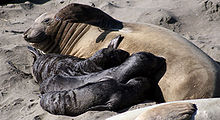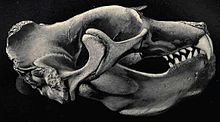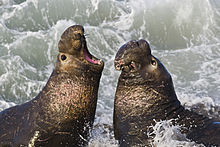- Northern elephant seal
-
Northern elephant seal 
Male, female and pup Conservation status Scientific classification Kingdom: Animalia Phylum: Chordata Class: Mammalia Order: Carnivora Family: Phocidae Genus: Mirounga Species: M. angustirostris Binomial name Mirounga angustirostris
(Gill, 1866)
Distribution of the northern elephant seal (dark blue: breeding colonies; light blue: non-breeding individuals) The northern elephant seal (Mirounga angustirostris) is one of two species of elephant seal (the other is the southern elephant seal). It is a member of the family Phocidae ("true seals"). Elephant seals derive their name from their great size and from the male's large proboscis, which is used in making extraordinarily loud roaring noises, especially during the mating competition. There is a great sexual dimorphism in size. The males can grow to 14 ft (4 m) and 5,000 lb (2,300 kg), while the females grow to 11 ft (3 m) and 1,400 lb (640 kg). Correspondingly, there is a highly polygynous mating system, with a successful male able to impregnate up to 50 females in one season.
Contents
Description
The much larger male northern elephant seal typically weighs 1,500–2,300 kg (3,300–5,100 lbs) and measures 4–5 m (13.2–16.5 ft), although some males can weigh up to 3,700 kg (8,152 lbs).[2] Females can range from 400 to 900 kg (990-2,000 lbs) and measure from 2.5 to 3.6 m (8.2–11.9 ft).[3] Both adult and juvenile elephant seals are bar-skinned and black before molting. After molting they generally have a silver to dark gray coat that fades to brown yellow and tan. Adult males have hairless necks and chests speckled with pink, white and light brown. Pups are mostly black at birth and molt to a silver gray after weaning.
The eyes are large, round and black. The width of the eyes and a high concentration of low light pigments suggests that sight plays an important role in the capture of prey. Like all seals, elephant seals have atrophied hind limbs whose underdeveloped ends form the tail and tail fin. Each of the "feet" can deploy 5 long webbed fingers. This agile, dual palm is used to propel water. The pectoral fins are used little while swimming. While the hind limbs are unfit for locomotion on land, elephant seals use their fins as support to propel their bodies. They are able to propel themselves quickly (as fast as 8 km/h) in this way for short-distance travel, to return to water, catch up with a female or chase an intruder.
Like other seals, elephant seals have a bloodstream adapted to the cold in which a mixture of small veins surrounds arteries capturing heat from them. This structure is present in extremities such as the hind legs.
Range and ecology
The northern elephant seal lives in the Eastern Pacific Ocean. Feeding grounds extend from northern Baja California to northern Vancouver Island.[4] Males migrate as far north as Alaska and British Columbia,[4][5] while females migrate as far west as Hawaii.[4] They come ashore to breed, give birth and molt, mostly on offshore islands. While the pelagic range covers an enormous span, there are only about seven principal breeding areas, four of which are on islands off the coast of California. Recently increasing numbers have been observed in the Gulf of California. Breeding colonies exist at Channel Islands, Año Nuevo State Reserve, Piedras Blancas Light, Morro Bay State Park and the Farallon Islands in the US[6] and Isla Guadalupe, Isla Benito del Este and Isla Cedros in Mexico.[6] Some breeding has been observed at Castle Rock in Northern California and Shell Island off Oregon[7][8] and in January, 2009 the first elephant seal births were recorded in British Columbia at Race Rocks.[9] The California breeding population is now demographically isolated from the population in Baja California.[6]
The northern elephant seals are nocturnal deep feeders famous for the long time intervals they remain underwater.[10] This species dives to great depths while feeding, typically between 300 m (1,000 ft) and 800 m (2,600 ft); moreover, the Northern elephant seal will generally not feed in depths of less than 200 m (700 ft).[5] Both sexes eat a variety of prey including pelagic, deep water squid, Pacific hake, sharks, rays, and ratfish.[5][10] Octopoteuthis deletron squid are the most common prey item, found in the stomachs of 58% of individuals sampled off the coast of California.[11] Elephant seals don't need to drink as they get their water from food and broken down fats.
While hunting in the dark depths, it is partly thanks to the use of vision that the elephant seals seem to locate their prey; the bioluminescence of some prey animals can facilitate their capture. Elephant seals do not have a developed a system of echolocation in the manner of cetaceans, but it is assumed that their vibrissae, which are sensitive to vibrations, play a role in search of food. Males and females differ in both diving behavior. Males tend to hug the continental shelf while making deep dives and forage along the bottom,[4] while females have more jagged routes and forage in the open ocean.[4] Males return to the same feeding ground every year while female have less predictable feeding migrations. Elephant seals are preyed on by orcas and white sharks. Both are most likely to hunt pups and seldom hunt large bull elephant seals but have taken seals of all ages. The shark, when hunting adults, is most likely to ambush a seal with a damaging bite and wait to finish the kill until it is weakened by blood loss.[12]
Social behavior and reproduction
The Northern elephant seal returns to its terrestrial breeding ground in December and January, with the bulls arriving first. The bulls haul out on isolated or otherwise protected beaches typically on islands or very remote mainland locations. It is important that these beach areas offer protection from the winter storms and high surf wave action.[13] The bulls engage in fights of supremacy to determine which few bulls will achieve a harem.[14][15]
 Three pups are nursing from the single female. As far as we[who?] know, female elephant seals deliver only one pup. The two other probably wandered around and got lost. In this situation no pup would get enough milk.
Three pups are nursing from the single female. As far as we[who?] know, female elephant seals deliver only one pup. The two other probably wandered around and got lost. In this situation no pup would get enough milk.
After the males have arrived the beach, the females arrive to give birth. Females fast for 5 weeks and nurse their single pup for 4 weeks; in last few days of lactation, females come into estrus and mate.[16] In this polygynous society, a high-ranking bull will typically have a harem of 30–100 cows depending on the size and strength of the bull. Low ranking males are kept out of the harems but will try to copulate with females on the periphery or in the water with females that are leaving.[14] Dominant bulls will prevent lower ranking bulls from mounting cows and disrupt their copulations.[14] Both a male's freedom to be able to copulate without inference and how often it can interfere with the copulation of others depends how high it is in the dominance hierarchy.[14] However, dominant males commonly break off a copulation to chase off rivals.[14] While fights are not usually to the death, they are brutal and often with significant bloodshed and injury; however, in many cases of mismatched opponents, the younger, less capable males are simply chased away, often to upland dunes. In a lifetime a successful bull could easily sire over 500 pups. The majority of copulations in a breeding colony are done by only a few males with less than one third of the bulls being able to mate with a female.[15] Pups are sometimes crushed during battles between bulls.[13][15]
After arrival on shore males fast for three months, and females fast for five weeks during mating and when nursing of their pups. The gestation period is approximately eleven months. Sometimes, a female can become very aggressive after giving birth and will defend her pup from other females.[17] Such aggression is more common in crowded beaches.[17] While most females nurse their own pup and reject nursings from alien pups, some do accept alien pups with their own.[13][16] An orphaned pup may try to find another female to suckle and are commonly adopted at least on Año Nuevo island.[13][16] Pups nurse about four weeks and are weaned abruptly approximately two months before being abandoned by their mother. Left alone weaned pups will gather into groups and stay on shore for 12 more weeks. The pups learn how to swim in the surf and eventually swim farther to forage. Thus their first long journey at sea begins.
History and status
 The northern elephant seal population was estimated to be 171,000 in 2005.[1]
The northern elephant seal population was estimated to be 171,000 in 2005.[1]
Beginning in the 18th century northern elephant seals were hunted extensively almost to extinction by the end of the 19th century,[1] being prized for oil that could be made from their blubber, and the population may have fallen as low as 20.[1] In 1874 Charles Melville Scammon recorded in "Marine Mammals of the Northwestern Coast of America," that a eighteen feet-long bull caught on Santa Barbara Island yielded 210 gallons of oil.[18] They were thought to be extinct in 1884 until a remnant population of eight individuals was discovered on Guadalupe Island in 1892 by a Smithsonian expedition, who promptly killed seven of the eight for their collections.[19] The elephant seals managed to survive, and were finally protected by the Mexican government in 1922. Since the early 20th century, they have been protected by law in both Mexico and in the United States. Subsequently the U.S. protection was strengthened after passage of the Marine Mammal Protection Act, and numbers have now recovered to over 100,000.
Nevertheless, there is a genetic bottleneck in the existing population, which could make it more susceptible to disease and pollution [20][21] In California, the population is continuing to grow at around 25% per year, and new colonies are being established; they are now probably limited mostly by the availability of haulout space. However, numbers can be adversely affected by El Niño events and the resultant weather conditions, and the 1997–98 El Niño may have caused the loss of about 80% of that year's pups. Presently the northern elephant seal is protected under the Federal Marine Mammal Act and under California law has a fully protected status.
Populations of rookery sites in California have increased during the past century.[1] At Año Nuevo State Park, for example, there were no individuals observed whatsoever until the 1950s; the first pup born there was observed in the early 1960s. Currently, thousands of pups are born every year at Año Nuevo, on both the island and mainland. The growth of the site near San Simeon has proved even more spectacular; there were no animals there prior to 1990. Currently, the San Simeon site hosts more breeding animals than Año Nuevo State Park during winter season.
References
- ^ a b c d e Campagna, C. (2008). Mirounga angustirostris. In: IUCN 2008. IUCN Red List of Threatened Species. Downloaded on 28 January 2009.
- ^ Beer, Encyclopedia of North American Mammals: An Essential Guide to Mammals of North America. Thunder Bay Press (2004), ISBN 978-1592231911.
- ^ Mirounga angustirostris. Northern Elephant Seal. Smithonian National Museum of Natural History
- ^ a b c d e Le Boeuf, B., D. Crocker, D. Costa, S. Blackwell, P. Webb (2000). "Foraging ecology of northern elephant seals". Ecological Monographs 70 (3): 353–382.
- ^ a b c R. Condit and B.J. LeBoeuf (1984). "Feeding Habits and Feeding Grounds of the Northern Elephant Seal". J. Mammal 65 (2): 281–290. doi:10.2307/1381167.
- ^ a b c U.S. Pacific Marine Mammal Stock Assessments: 2007 (NMFS-SWFSC-414). (PDF) . Retrieved on 2011-09-15.
- ^ Stewart BS, Yochem PK, Huber HR, DeLong RL, Jameson RJ, Sydeman WJ, Allen SG, Le Boeuf BJ (1994) "History and present status of the Northern elephant seal population". In: Le Boeuf BJ, Laws RM (eds) Elephant Seals: Population Ecology, Behavior, and Physiology. University of California Press, Berkeley, CA, pp. 29–48.
- ^ Hodder J, Brown RF, Cziesla C (1998). "The northern elephant seal in Oregon: A pupping range extension and onshore occurrence". Marine Mammal Science 14: 873–881. doi:10.1111/j.1748-7692.1998.tb00772.
- ^ Elephant Seal birth of baby ninene. Racerocks.com. Retrieved on 2011-09-15.
- ^ a b G.V. Morejohn and D.M. Beltz (1970). "Contents of the stomach of an elephant seal". Journal of Mammalogy 51 (1): 173–174. doi:10.2307/1378554.
- ^ Le Beouf, Burney J.; Richard M. Laws (1994). Elephant Seals: Population ecology, behavior, and physiology. University of California Press. pp. 213–214. ISBN 9780520083646.
- ^ White Sharks – Carcharodon carcharias. Pelagic Shark Research Foundation.
- ^ a b c d M.L. Riedman and B.J. LeBoeuf (1982). "Mother-pup separation and adoption in northern elephant seals". Behav. Ecol. Sociobiol 11 (3): 203–213. doi:10.1007/BF00300063. JSTOR 4599535.
- ^ a b c d e Leboeuf BJ (1972). "Sexual behavior in the Northern Elephant seal Mirounga angustirostris". Behaviour 41 (1): 1–26. doi:10.1163/156853972X00167. JSTOR 4533425. PMID 5062032.
- ^ a b c Leboeuf BJ (1974). "Male-male competition and reproductive success in elephant seals". Amer. Zool. 14: 163–176. doi:10.1093/icb/14.1.163.
- ^ a b c Leboeuf BJ; Whiting, R. J.; Gantt, R. F. (1972). "Perinatal behavior of northern elephant seal females and their young". Behaviour 43 (1): 121–156. JSTOR 4533472. PMID 4656181.
- ^ a b T. E. Christenson and B. J. Le Boeuf (1978). "Aggression in the Female Northern Elephant Seal, Mirounga angustirostris". Behaviour 64 (1/2): 158–172. doi:10.1163/156853978X00495. JSTOR 4533866.
- ^ Charles Melville Scammon (2007). The marine mammals of the northwestern coast of North America: together with an account of the American whale-fishery. Heyday Press. p. 132. ISBN 9781597140614. http://books.google.com/books?id=GJ1tlnhkTWcC&printsec=frontcover. Retrieved 2011-09-05.
- ^ Briton Cooper Busch (1987). The War Against the Seals: A History of the North American Seal Fishery. McGill-Queen's Press. p. 187. ISBN 9780773506107. http://books.google.com/books?id=Q4WF3PTh4kQC&pg=PA187. Retrieved 2011-09-05.
- ^ Hoelzel, A. R., Fleischer, R. C., Campagna, C., Le Boeuf, B. J. and Alvord, G. (2002). "Impact of a population bottleneck on symmetry and genetic diversity in the northern elephant seal". Journal of Evolutionary Biology 15 (4): 567–575. doi:10.1046/j.1420-9101.2002.00419.x.
- ^ Weber, D. S., Stewart, B. S., Garza, J. C. & Lehman, N. (2000). "An empirical genetic assessment of the severity of the northern elephant seal population bottleneck". Current Biology 10 (20): 1287–1290. doi:10.1016/S0960-9822(00)00759-4. PMID 11069110.
External links
- Marine Mammal Center – Northern Elephant Seal
- SCS: Northern Elephant Seal
- Elephant Seal Research Group
- Elephant Seals – Earthguide
Categories:- IUCN Red List least concern species
- True seals
- Arctic pinnipeds
- Mammals of Canada
- Megafauna
- Megafauna of North America
- Megafauna of Eurasia
- Fauna of Mexico
- Mammals of the United States
- Western North American coastal fauna
Wikimedia Foundation. 2010.




